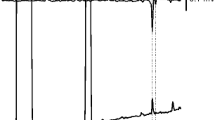Abstract
Two major components from pheromone gland extracts of Synanthedon haitangvora females were identified as (Z,Z)-3,13-octadecadienyl acetate (Z3,Z13-18:OAc) and (E,Z)-2,13-octadecadienyl acetate (E2,Z13-18:OAc), and the average ratio of these components was about 1:1. Seven minor components, (Z)-9-hexadecenyl acetate (Z9-16:OAc), (Z)-11-hexadecenyl acetate (Z11-16:OAc), (Z)-9-octadecenyl acetate (Z9-18:OAc), (Z)-13-octadecenyl acetate (Z13-18:OAc), (E,Z)-3,13-octadecadienyl acetate (E3,Z13-18:OAc), (Z,Z)-3,13-octadecadien-1-ol (Z3,Z13-18:OH), and (E,Z)-2,13-octadecadien-1-ol (E2,Z13-18:OH), also were identified from gland extracts. Field tests showed that male S. haitangvora were attracted to Z3,Z13-18:OAc alone, but the maximum number of males was attracted to the binary blend of Z3,Z13-18:OAc and E2,Z13-18:OAc mimicking the blend found in female extracts. The addition of minor components to a 1:1 blend of Z3,Z13-18:OAc and E2,Z13-18:OAc did not increase the numbers of moths captured. The only significant effect of minor components was the strong inhibitory effect of adding Z3,Z13-18:OH to the primary binary blend. Increasing doses of the optimum pheromone blend in the lures from 0.1 to 2.0 mg increased trap catches of male S. haitangvora.




Similar content being viewed by others
References
Arita, Y., Bae, Y. S., Lee, C. M., and Ikeda, M. 2004. Sesiidae (Lepidoptera) of Korea. Trans. Lepid. Soc. Japan 55:1–12.
El-Sayed, A. M. 2009. Internet database: http://www.pherobase.com/.
Klun, J. A., Schwarz, M., Leonhardt, B. A., and Cantelo, W. W. 1990. Sex pheromone of the female squash vine borer (Lepidoptera: Sesiidae). J. Entomol. Sci. 25:64–72.
Lee, C. M. 2004. A taxonomic study of Sesiidae (Insecta: Lepidoptera) in Korea. MS dissertation. University of Incheon, Korea.
Löfstedt, C., Herrebout, W. M., and Menken, S. B. J. 1991. Sex pheromones and their potential role in the evolution of reproductive isolation in small ermine moths (Yponomeutidae). Chemoecology 2:20–28.
Matsumoto, K., Nakamuta, K., and Nakashima, T. 2007. Mating disruption controls the cherry tree borer, Synanthedon hector (Butler) (Lepidoptera: Sesiidae), in a steep orchard of cherry trees. J. For. Res. 12:34–37.
Mozûraitis, R., and Karalius, V. 2007. Identification of minor sex pheromone components of the poplar clearwing moth Paranthrene tabaniformis (Lepidoptera, Sesiidae). Z. Naturforsch. 62c:138–142.
Mozûraitis, R., Karalius, V., Buda, V., and Borg-Karlson, A. K. 2006. Inter- and intraspecific activities of compounds derived from sex pheromone glands of currant borer, Synanthedon tipuliformis (Clerck) (Lepidoptera: Sesiidae). Z. Naturforsch. 61c:278–284.
Naka, H., Nakazawa, T., Sugie, M., Yamamoto, M., Horie, Y., Wakasugi, R., Arita, Y., Sugie, H., Tsuchida, K., and Ando, T. 2006. Synthesis and characterization of 3,13- and 2,13-octadecadienyl compounds for identification of the sex pheromone secreted by a clearwing moth, Nokona pernix. Biosci. Biotechnol. Biochem. 70:508–516.
Roelofs, W. L., and Brown, R. L. 1982. Pheromones and evolutionary relationships of Tortricidae. Annu. Rev. Ecol. Evol. Syst. 13:395–422.
SAS Institute. 2004. Statview. SAS Institute Inc., Cary.
Tamaki, Y., Yushima, T., Oda, M., Kida, K., Kitamura, K., Yabuki, S., and Tumlinson, H. H. 1977. Attractiveness of 3,13-octadecadienyl acetates for males of clearwing moths. Jap. J. Appl. Entomol. Zool. 21:106–107.
Van den Dool, H., and Kratz, P. D. 1963. A generalization of the retention index system including linear temperature-programmed gas–liquid partition chromatography. J. Chromatogr. 2:463–471.
Vincenti, M., Guglielmetti, G., Cassani, G., and Toninni, C. 1987. Determination of double-bond position in diunsaturated compounds by mass-spectrometry of dimethyl disulfide derivatives. Anal. Chem. 59:694–699.
Weihman, S. W., and Liburd, O. E. 2006. Mating disruption and attract-and-kill as reduced-risk strategies for control of grape root borer Vitacea polistiformis (Lepidoptera: Sesiidae) in Florida vineyards. Fla. Entomol. 89:245–250.
Yang, C. Y., Han, K. S., and Boo, K. S. 2009. Sex pheromones and reproductive isolation of three species in genus Adoxophyes. J. Chem. Ecol. 35:342–348.
Zhang, A., Leskey, T. C., Bergh, J. C., and Walgenbach, J. F. 2005. Sex pheromone of the dogwood borer, Synthedon scitula. J. Chem. Ecol. 31:2463–2479.
Acknowledgements
The authors thank Prof. Yang Seop Bae for identification of S. haitangvora and two anonymous reviewers for invaluable comments.
Author information
Authors and Affiliations
Corresponding author
Rights and permissions
About this article
Cite this article
Yang, C.Y., Kim, J., Kang, T.J. et al. Identification and Field Bioassays of the Sex Pheromone of Synanthedon haitangvora . J Chem Ecol 35, 1197–1201 (2009). https://doi.org/10.1007/s10886-009-9694-5
Received:
Revised:
Accepted:
Published:
Issue Date:
DOI: https://doi.org/10.1007/s10886-009-9694-5




